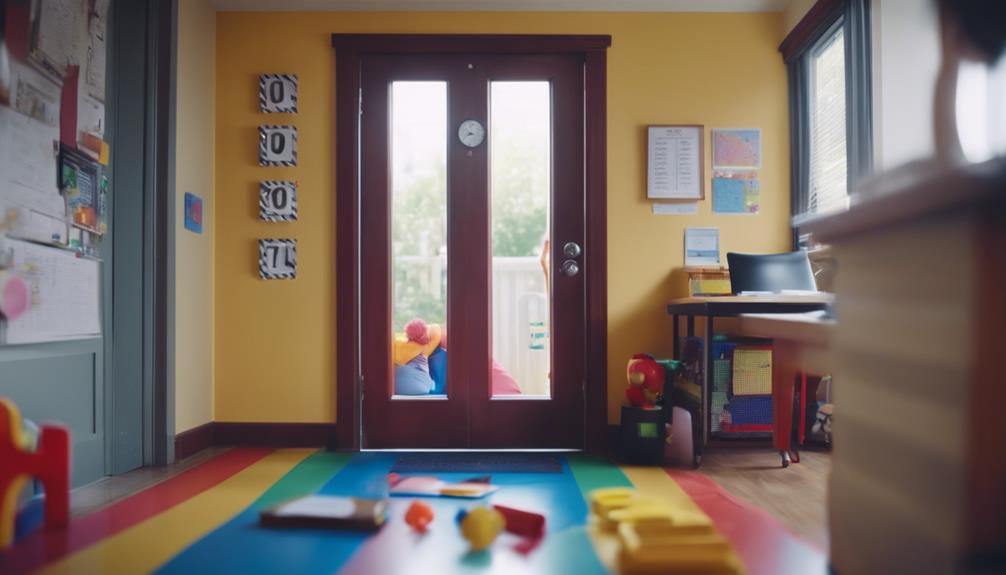Balancing remote work with kids can be challenging, but clear boundaries help. First, I communicate my work hours to prevent interruptions. I've created a dedicated workspace to separate my job from family life. I also set specific work hours, which boosts productivity and keeps my routine intact. Scheduling daily quality time with my children strengthens our bond and guarantees they feel prioritized. Visual cues, like a "do not disturb" sign, help kids understand when I need focus time. These strategies create a nurturing environment for both work and family. Interested in learning more practical tips? You'll find them up next.
Key Takeaways
- Communicate specific work hours to family members to ensure undisturbed focus.
- Designate a separate workspace to create physical and psychological boundaries between work and family life.
- Use visual cues like 'Do not disturb' signs to signal when you're unavailable.
- Establish and adhere to a daily schedule that includes dedicated family time.
- Implement color-coded calendars to clearly show work and family availability.
Communicate Expectations Clearly
Setting clear expectations with your family about your remote work hours and the importance of minimizing interruptions is essential for maintaining productivity. I've found that outlining my work hours and setting boundaries helps everyone understand when I need to focus.
Communicating the importance of undisturbed work time to my family has been vital. We established rules for communication during my work hours, ensuring I can maintain my focus. Visual cues, like a sign on my office door, indicate when I'm not to be disturbed.
Designate a Workspace
Establishing a designated workspace is essential for separating work from family life and boosting productivity. When I work from home, having a specific area signals to my family members, especially my kids, that I'm in work mode. It helps create physical boundaries, reducing distractions and interruptions. Here are some benefits I've found:
| Benefit | Impact |
|---|---|
| Increased Focus | Dedicated space helps me concentrate better. |
| Routine and Structure | Establishes a consistent work routine. |
| Clear Signals to Family | Indicates to kids when I'm working and shouldn't be disturbed. |
Creating this space not only enhances my productivity but also fosters a sense of structure. It's a small step that makes a big difference in balancing work and family life.
Set Work Hours

Establishing clear work hours is essential for maintaining a healthy balance between professional responsibilities and family life. When I set specific work hours, it not only boosts my productivity but also helps me stay focused amidst the chaos of remote work with kids. Research from FlexJobs shows that 82% of remote workers find this practice important for achieving work-life balance.
Plan Family Time
I make it a point to schedule daily quality moments with my kids and prioritize weekend activities to strengthen our bond.
Research shows that these intentional interactions boost their emotional well-being and foster better behavior.
Schedule Daily Quality Moments
When we schedule daily quality moments with our family, we not only create cherished memories but also foster stronger emotional connections and a healthier work-life balance. By setting aside specific blocks of time for family activities, we can improve communication and strengthen relationships. Research indicates that regular family time is linked to increased happiness and reduced stress levels, benefiting everyone involved.
| Benefits of Family Time | Impact |
|---|---|
| Improved Communication | Strengthened Relationships |
| Increased Happiness | Reduced Stress Levels |
| Enhanced Children's Emotional Well-Being | Sense of Belonging |
| Cherished Memories | Fostered Togetherness |
Taking these intentional steps to plan family time helps create a nurturing environment where both work and personal life can thrive harmoniously.
Prioritize Weekend Activities
By prioritizing weekend activities, we can build on the daily quality moments we've established and guarantee our family connections grow even stronger.
Research shows that setting aside dedicated family time on weekends greatly boosts overall family satisfaction and well-being. Planning fun and meaningful activities not only strengthens family bonds but also creates lasting memories for our children. This approach reduces stress and promotes a healthier work-life balance.
Use Visual Cues

Incorporating visual cues into your remote work routine can greatly help children understand and respect your work boundaries. As a working parent, I've found that simple strategies like a closed door or a 'work' sign make a big difference.
Visual timers or clocks can effectively signal to kids when my work time ends and their time begins. Color-coded calendars also work wonders, clearly showing when I'm busy and when I'm available for family activities. Visual reminders, such as sticky notes or symbols, reinforce these boundaries.
A 'do not disturb' sign guarantees everyone knows when I need uninterrupted focus. These visual cues promote a harmonious balance between work and family life, fostering a more productive and respectful environment for all.
Create a Routine
Establishing a consistent daily routine can provide much-needed structure for both work and family activities, helping everyone feel more grounded. Research shows that routines reduce anxiety and promote stability, essential for maintaining a harmonious environment.
By setting clear boundaries between work hours and family time, I can effectively balance my responsibilities, ensuring I'm present for both professional tasks and personal moments. This predictability helps my kids understand changes, improving their behavior and sleep patterns. It's not just about rigid schedules but creating a flow that adapts to our needs while maintaining consistency.
A well-planned routine fosters a healthier work-life balance, allowing me to prioritize and meet my work commitments without neglecting family needs.
Involve Kids in Planning

Getting my kids involved in planning our daily routine not only empowers them but also fosters a sense of shared responsibility and cooperation. We create a visual schedule together, which helps them understand the balance between work and family time. By encouraging them to contribute ideas for activities during my breaks, they feel valued and engaged. I also discuss my work expectations with them to establish mutual understanding and set boundaries for interruptions. Teaching them to respect workspace boundaries and signal when it's important to interact is essential. Here's a quick look at our planning process:
| Task | Who's Involved | Purpose |
|---|---|---|
| Visual Schedule | Me and Kids | Balance Work/Family Time |
| Break Activity Ideas | Kids | Engagement and Inclusion |
| Work Expectations | Me and Kids | Setting Boundaries |
Frequently Asked Questions
How Do You Set Boundaries When Working With Children?
I set boundaries by creating a dedicated workspace and using flexible scheduling. I explain my work hours to my kids and use visual cues to signal when I shouldn't be interrupted. This fosters a balanced, productive environment.
How Do You Set Boundaries With Family When Working From Home?
I've found that setting clear boundaries with family when working from home involves creating a designated workspace and taking scheduled breaks. This helps maintain focus and balance, ensuring both work and family time are respected and productive.
How Can I Work Remotely With My Child at Home?
Imagine juggling flaming torches while balancing on a unicycle—working remotely with my child at home feels like that. I explore childcare alternatives and use flexible scheduling to guarantee both work and developmental needs are met.
How to Set Strong Work Life Boundaries as a Remote Worker?
To set strong work-life boundaries, I prioritize time management and create a designated workspace. I communicate my work hours clearly, use visual cues, and consistently balance work and family time to maintain productivity and harmony.
Conclusion
To sum up, by clearly communicating expectations, designating a workspace, and setting work hours, I've found a harmonious balance. Planning family time and using visual cues make a world of difference, while creating a routine and involving the kids in planning guarantees everyone's on board.
Though it's not always a walk in the park, these strategies transform remote work with kids from chaos to a well-oiled machine. Remember, Rome wasn't built in a day, but with patience, it can be manageable.






